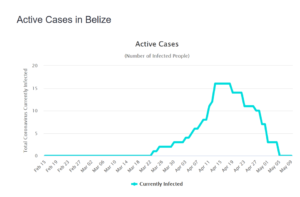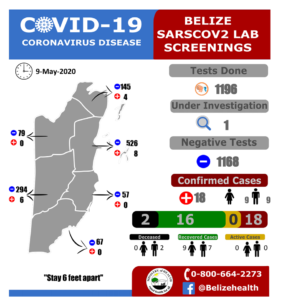Belize COVID-19 Update
By: Daniel Mendez
COVID-19 continues to cause major health, economic, social and psychological impacts across the Americas. As of 10 May 2020, there were 1,702,451 confirmed cases, with 101,874 reported deaths (PAHO, 2020). In the Central American region, Panama has the highest number of confirmed cases (8,282), with other high numbers noted in Costa Rica (780) and Honduras (1,830). Guatemala has reported 967 cases, while Mexico has a total of 33,460 confirmed cases (PAHO, 2020).
Table 1: Cumulative confirmed and probable COVID-19 cases (Source: PAHO)
|
Country |
Confirmed Cases |
Deaths |
Recovered |
|
Panama |
8,282 |
237 |
4,501 |
|
Nicaragua |
16 |
5 |
7 |
|
Costa Rica |
780 |
6 |
480 |
|
Honduras |
1, 830 |
108 |
165 |
|
El Salvador |
889 |
17 |
293 |
|
Guatemala |
967 |
24 |
104 |
|
Belize |
18 |
2 |
16 |
|
Mexico |
33,460 |
3,353 |
5,715 |
Belize, located in both Central America and the Caribbean, has not escaped unscathed as the virus continues its spread in the region. The country has confirmed 18 cases and fortunately, only two deaths. As of 11 May, there were no active cases, 16 persons have recovered and there have been two deaths (Belize Ministry of Health, 2020).
Figure 1: Active COVID-19 Cases in Belize (Source: Belize Ministry of Health)

Тhіѕ іѕ thе 28th соnѕесutіvе dау wіth nо nеw саѕеѕ rероrtеd, while 36 реrѕоnѕ rеmаіn undеr іnvеѕtіgаtіоn. Thе Міnіѕtrу оf Неаlth hаѕ bееn concentrating its efforts on hеаlth саrе wоrkеrѕ ехроѕеd tо СОVІD-19 while оn thе јоb аnd ѕоmе ѕесоndаrу аnd tеrtіаrу соntасtѕ of the positive patients. Thе Government of Belize has also extended the current ѕtаtе оf еmеrgеnсу whісh ехріrеѕ on the 1st of May for a further 60 days.
Figure 2: Current COVID-19 Status (Source: Belize Ministry of Health)

Although the Ministry of Health has not yet provided any analysis on Belize’s low numbers, it can be inferred that the steps that were taken several weeks ago have been effective. The first case was reported on the 23rd of March, but several steps had already been taken weeks before. These included:
- Closure of schools for 14 days;
- Limiting social gatherings to 100 persons;
- Prohibition of entry into Belize by nationals of and persons who had travelled within the last 30 days from China, Hong Kong, Iran, Japan, South Korea, and Europe, including the United Kingdom; and
- Closure of all ports of entry in Belize for passengers, except for the Mexico-Belize border and the international airport. This did not apply to cargo vessels.
When the first case was reported on the island of San Pedro, the Government then declared a State of Emergency and announced a 14-day quarantine on the island, embarked on contact tracing and began testing. As further cases were reported, the Government added further layers of measures within the affected communities, as well as nationally. On the 25th of March, it was announced that: people had to form a line to access services and maintain a distance of at least 3 feet between each other; social gatherings were limited to no more than 10 people; and that individuals who are ill and are exhibiting flu-like symptoms are to refrain from accessing services in person.
On 1 April, the Government of Belize declared a nationwide state of emergency for 30 days and implemented a curfew from 20:00 to 05:00 and imposed a lockdown intended to dissuade people from leaving their homes except for specific reasons. These specific reasons included buying essential goods, attending medical appointments or to work in essential services. Police were given power to stop and question anyone who was moving around during the curfew and arrest anyone violating the orders. Belize closed its terrestrial and marine borders with Mexico and Guatemala and closed the Philip S.W. Goldson International Airport to all flights except for cargo. The last time a nationwide state of emergency was declared was in 1981, in response to major social unrest surrounding the independence movement.
As the numbers in Belize have decreased to 0, the general sentiment of the people seems to be acceptance that the measures need to continue, albeit the need to open the country’s suffering economy. From my perspective, the Government has been doing a very good job at crisis communications, broadcasting a daily information session called “Ask the Experts”, providing daily COVID-19 updates from the Ministry of Health and hosting regular Prime Minister press conferences. The extension of the state of emergency allows the government to slowly open the country in a measured and careful manner. This is very important given the high numbers of cases among our immediate neighbours – Mexico, Guatemala and Honduras. At this point, the government needs to ensure that it balances the need to protect the damaged economy and the affected sectors (e.g. tourism, agriculture and production) with the need to prevent any future infections in the country. Belize has successfully controlled the spread of COVID-19 but now needs to look to the medium and long-term recovery of the country.
References:
Ministry of Health (2020) ‘Belize SARSCOV2 Lab Screenings’, available online at: https://www.facebook.com/GOBPressOffice/photos/a.725115727523933/2866965340005617/?type=3&theater, accessed April 29, 2020.
PAHO (2020) ‘Cumulative confirmed and probable COVID-19 cases reported by countries and territories in the Americas, as of 28 April 2020 Updated as of 2PM’, available online at: https://ais.paho.org/phip/viz/COVID19Table.asp, accessed April 29, 2020.
